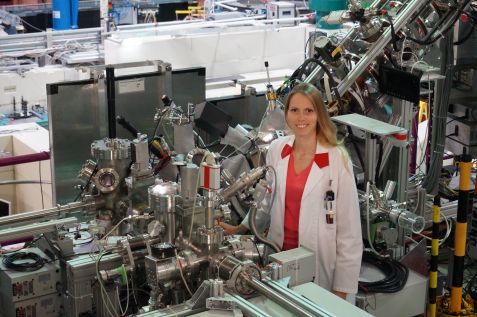MLZ is a cooperation between:
 > Technische Universität München
> Technische Universität München > Helmholtz-Zentrum Hereon
> Helmholtz-Zentrum Hereon
 > Forschungszentrum Jülich
> Forschungszentrum Jülich
MLZ is a member of:
 > LENS
> LENS > ERF-AISBL
> ERF-AISBL
MLZ on social media:

MLZ (eng)
Lichtenbergstr.1
85748 Garching
2.6.2016
Again excellent female scientist of the FRM II awarded

The Laura Bassi price is connected with a scholarship that facilitates Samantha Zimnik conduct her experiments at the instrument NEPOMUC until her dissertation. © privat
Samantha Zimnik was granted with the Laura Bassi price for her outstanding scientific achievements in the field of surface physics at the positron source NEPOMUC.
The physicist already completed her studies in physics at the Technical University of Munich (TUM) with very good results and is working since 2013 on her doctorate in the research group “Physics with Positrons” of PD Dr. Christoph Hugenschmidt at the Chair for Neutron Scattering (E21) of Professor Peter Böni. She will complete her thesis for positron annihilation induced Auger Electron Spectroscopy (PAES) in the middle of next year. “The Laura Bassi price helps me enormously to successfully complete the research phase of my PhD and opens many opportunities in my scientific work,” says the winner.
PAES is a newly developed method for the study of surfaces with which the elemental composition of the uppermost atomic layer of a sample can be analyzed. The positrons generated at the positron source NEPOMUC (NEutron induced POsitron source MUniCh) serve as highly sensitive probes for the study of solid surfaces. Only few analytical methods are at all able to study exclusively the elemental composition the topmost atomic layer of a solid, PAES allows this analysis. NEPOMUC uses the worldwide most intense source with 109 positrons per second, therefore PAES measurements can be carried out time-dependent. The measurement time may here be reduced from several days to just a few minutes, so that surface processes can be observed directly. In her dissertation Samantha Zimnik uses the PAES results and compares them which that of opposite complementary techniques. ”Awarding the Laura Bassi prize for her excellent research activities is well-deserved, since Ms. Zimnik always shows outstanding interest in solving sophisticated scientific problems,” says PD Dr. Christoph Hugenschmidt being highly pleased about the award of his PhD student. “Ms Zimnik is not only an excellent physicist with already very many publications, she also gives excellent motivating talks, which show her enthusiasm for physics,” Professor Peter Böni compliments the prize winner.
While studying Samantha Zimnik already has very successfully participated in the UnternehmerTUM’s Manage & More program, which provides students of the Munich universities with a 3-semester scholarship to further train their entrepreneurial skills. During this program she worked in a team on several industrial projects to quite different subjects and technologies, all of which had nothing to do with physics.
With the Laura Bassi prices TUM supports outstanding scientists. The Bavarian State Ministry of Education and Culture, Science and Arts is providing the necessary funding. Laura Bassi was the first female scientist in the 18th century, who got a chair in philosophy and later in physics at the University of Bologna. She enjoyed already at that time an excellent reputation throughout Europe because of her scientific excellence.
MLZ is a cooperation between:
 > Technische Universität München
> Technische Universität München > Helmholtz-Zentrum Hereon
> Helmholtz-Zentrum Hereon
 > Forschungszentrum Jülich
> Forschungszentrum Jülich
MLZ is a member of:
 > LENS
> LENS > ERF-AISBL
> ERF-AISBL
MLZ on social media:


